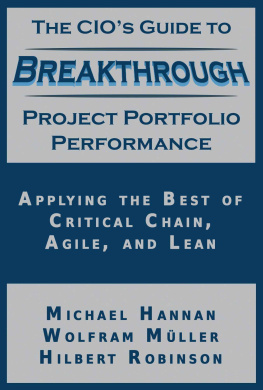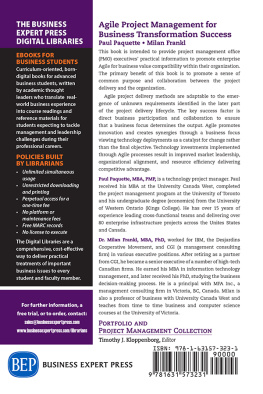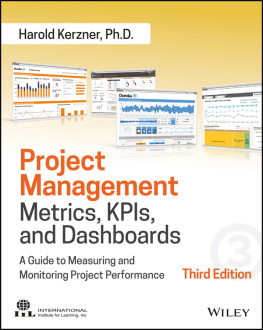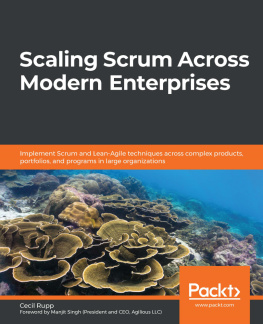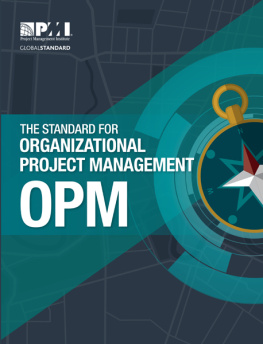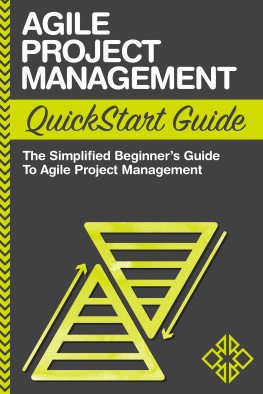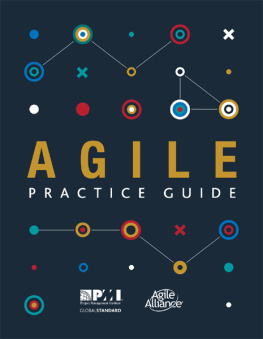The CIOs Guide to Breakthrough Project Portfolio Performance
Applying the Best of
Critical Chain, Agile, and Lean
Michael Hannan
Wolfram Mller
Hilbert Robinson
Copyright 2014 by Fortezza Consulting, LLC.
All rights reserved. This book or any portion thereof may not be reproduced or used in any manner whatsoever without the express written permission of the publisher except for the use of brief quotations in a book review or scholarly journal.
First Pr inting: 2014
www.FortezzaConsulting.com
ASIN B00MHYS0T0 (Kindle eBook)
ISBN 978-1-63443-943-5 (hard cover)
ISBN 978-1-63443-942-8 (paperback)
ISBNs listed in Books in Print under Primedia E-launch LLC
Printed in the United States of America
Dedication
For Krista, Carlos, Pablo, and Jos
Table of C ontents
Accolades
"This book's value is that it's devoted to identifying specific techniques, derived from multiple leading methodologies, for a singular purpose: optimizing project portfolio performance. Whether youre a CIO, an IT PMO Director, or a PM, youll find this book to be an eye-opening framework on how to significantly increase the probability that your suite of projects will be successfully accomplished."
Bobby German, former CIO of NASA
This book fills a huge void in the IT Project Portfolio Management worldit exposes the major drivers of subpar performance, and offers a clear, concise, best-tool-for-the-job approach for jacking up the speed, reliability, and business impact of any organizations IT projects.
Laura Barnard, Founder & CEO of PMO Strategies,
former VP of Enterprise Transformation at Freddie Mac,
former VP of Enterprise PMO at T. Rowe Price
The techniques described here will foster an optimal environment in which people naturally perform highly productive work, while keeping to common goals. The authors integrate an eclectic mix of commonly used methods, with key clever, innovative and performance-enhancing twists, to get the most out of the group with the least stressthe grail for any CEO or program manager.
J. Kendall Lott, CEO of M Powered Strategies,
CEO & Chairman of the Governance Board,
PMI Washington DC Chapter
Acknowledgments
We would like to thank Roy Maizel, who was Mikes first mentor in program and project management at NASA, and all of the wonderful people at NOVACES who have supported Mike and Hilbert over the past few years. We also acknowledge Laura Barnard and Kendall Lott for all manner of advice and support surrounding the ideas in this book, and Bobby German for his sage counsel in the final editing phase. And, finally, thanks to Maureen Hannan for her expert copy-editing.
Purpose of this Book
Our driving passion is helping organizations achieve breakthrough improvements in the performance of their project portfolios. For this book, we focus that passion on the uniquely wonderful challenges and opportunities inherent in information technology (IT) project portfolios.
The failure rate of IT projects has remained stubbornly high, in spite of a host of methods offering promise of reliefto the point that very few project stakeholders actually expect IT project portfolios to deliver a high volume of reliable project completions. And even when we do find ways to deliver some IT projects faster and more reliably, that success has proved difficult to replicate across the portfolio. One-size-fits-all approachessuch as mandating that all projects adopt Agileoften produce a hit-or-miss track record, leaving chief executives scratching their heads wondering why some projects realize great success, while others do not.
Exacerbating these throughput and reliability problems is the general sense that many projects in our portfolios, even when they come in as planned, fail to deliver anywhere close to the level of organizational benefit originally envisioned. Sometimes this is because of over-inflated promises made in order to obtain approval, but the more fundamental root cause is simply that most organizations have misguided project selection processes.
When we talk about breakthrough portfolio-wide improvements, w e mean selecting much higher-impact projects, at least doubling the number of them that your organization can complete, and being able to deliver over 90 percent of them within planall within existing resource constraints. For profit-seeking enterprises, this translates to an effective return on investment (ROI) that is at least five times current levels, which in turn can multiply project-driven profits by 10X or better. For organizations measuring impact in terms other than profit, the breakthrough potential is commensurate.
As you might expect, achieving such dramatic results requires big changesin how we work, in how we manage work, in our organizational values, and in how we foster unity of purpose at all levels and build trust with all internal and external stakeholders. But we have demonstrated that it can be done, and this book will show you how to do it.
Chapter 1: The Three Most Important Objectives
The three most important objectives for any project portfolio are
1. Selecting the right projects.
Maximizing the portfolios throughput of project completions.
Optimizing the portfolios reliability of project completions.
To many CIOs and IT project portfolio management (PPM) practitioners, focusing on these three objectives might seem obviousof course we all want to pick high-impact projects and deliver a healthy volume of them reliably. The problem is that most of us havent quite figured out how to do it.
Just how bad is this problem? The Project Management Institute (PMI) does an annual survey of over 2,500 project-management leaders and practitioners from all over the world, and asks them to assess their organizations project-management performance. Here are a few of the more telling metrics from the most recent survey:
- Project selection: Only 42 percent of projects were classified as having high alignment to organizational strategy.
- Portfolio throughput: Only 9 percent of respondents consider their organizations excellent at executing their highest-priority projects.
- Portfolio reliability: Only 17 percent of respondents believe that their organizations are able to realize envisioned project benefits with high maturity.
Compounding this sad state of affairs is that most PPM solution approaches focus on only a part of the problem, or on addressing symptoms. For example, because portfolio reliability is so poor, projects going over budget must either siphon funds from other projects, or be killed or de-scoped to free up funds for other over-budget projects. As a result, the focus drifts from the root problem of poor reliability towards coming up with better approaches for deciding which projects to kill.
Its gotten so bad that even some of the largest-scale, most visible attempts to improve the performance of IT project portfolios fail to even mention throughput or reliability, while pointing to savings from killing or drastically de-scoping worthwhile projects. For example, the U.S. Federal Government launched an effort in 2010 to help improve the performance of its $60 billion-per-year IT project portfolio. A year later, the Federal CIO proudly cited almost $1 billion in cost reductions achieved, which sounds like a pretty good start. However, it turns out that nearly half of these cost reductions resulted from one-time data-center consolidations, and about a third came from terminating, halting, or de-scoping projects. Just $30M of the savings, a mere 0.5 percent of the Federal IT project portfolio, was attributed to accelerated delivery.

